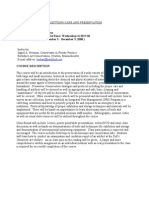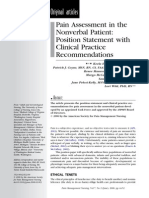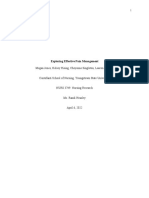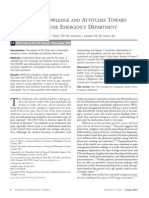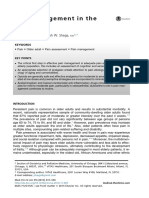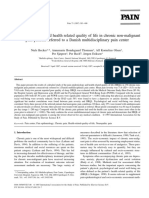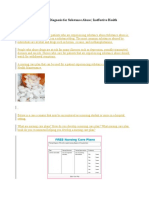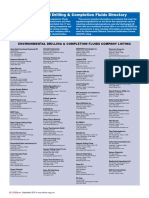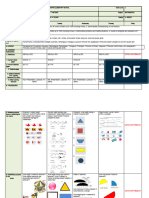Journal About Elderly
Journal About Elderly
Uploaded by
Kristine MaghariCopyright:
Available Formats
Journal About Elderly
Journal About Elderly
Uploaded by
Kristine MaghariOriginal Description:
Original Title
Copyright
Available Formats
Share this document
Did you find this document useful?
Is this content inappropriate?
Copyright:
Available Formats
Journal About Elderly
Journal About Elderly
Uploaded by
Kristine MaghariCopyright:
Available Formats
PAIN EXPERIENCE OF THE ELDERLY
Abstract Too often, the elderly suffer silently and needlessly with chronic pain. To investigate the pain experience of the elderly living in the community, a descriptive research design was used. The aims of the study were to determine the prevalence of pain in an older population living in the community, to obtain a description of the older adult's pain experience, and to determine strategies used to manage their pain. The results of the study indicated that >90% of the elderly living in the community experienced pain within the past month, with 41% reporting discomforting, distressing, horrible, or excruciating pain. Musculoskeletal pain was found to be the most predominant pain, and inactivity was the most effective strategy used to lessen pain. Pain in the elderly continues to be a challenge which needs to be addressed more effectively by health care providers. Based on the high prevalence of pain experienced by the elderly and the expected demographic shifts in the next two decades, it is imperative to continue research in this area to assure the highest quality of life, as well as maximum functional ability, for the elderly. Health care providers need to understand the multidimensional pain experience that occurs in the daily life of the community-dwelling older adult and the most effective management strategies that can be used to provide pain relief. Introduction Pain in the elderly is often undertreated and not valued as a significant health issue. However, unmanaged chronic pain can result in a severely diminished lifestyle and quality of life as the elderly cope with varying degrees of discomfort. Pain disrupts sleep patterns, inhibits routine daily activities, alters social activities with others, and often results in depression. Although new analgesics are entering the market frequently and nonpharmacologic approaches are increasing in use, the geriatric population continues to experience inadequate treatment of pain. Pain research with the elderly has predominantly focused on management of acute postoperative pain and pain associated with specific chronic illnesses; however, limited research has been conducted on the well elderly's pain experience. Pain is a common symptom in the elderly population, with extensive variation in prevalence rates from 25% to 80% (Crook, Rideout, & Browne, 1984; Ferrell & Ferrell, 1996; Ferrell, Ferrell, & Osterweil, 1990; Henkel, 2003; Jacobs, Hammerman-Rozenberg, Cohen, & Stessman, 2006; Landi et al., 2001; Sauaia, Sung-joon Min, Leber, Erbacher, Abrams, & Fink, 2005; Scharff & Turk, 1998). Undertreatment and misdiagnosis frequently occur owing to the assumptions made by health care providers that pain is a normal consequence of aging (Foley, 1995; Herr & Mobily, 1992; Pasero, Reed & McCaffery, 1999; Weiner, 2007). In addition, the elderly often underreport their pain experiences because of this belief or a fear that they will be perceived negatively by their health care provider as being noncompliant (Scharff & Turk, 1998). Additional barriers to effective pain relief include concerns about addiction, side
effects, tolerance, and the erroneous belief that "good" patients do not complain (McCaffery & Pasero, 1999). Auret and Schug (2005) indicate that underutilization of opioids in elderly patients with chronic pain is caused by multiple factors, including poor assessment of pain, fear of polypharmacy and opiophobia, and avoidance of opiods because of the potential of adverse effects such as physical dependence, addiction, and tolerance. Based on the high prevalence of pain experienced by the elderly and the expected demographic shifts in the next two decades, it is imperative to continue research on pain in the elderly. In addition, nurses and other health care professionals need to have a clear understanding of the pain experience of the older adult and the management strategies that can be used to provide effective evidence-based approaches. The aims of the present study were threefold: 1) to assess the prevalence of pain in an older sample living in the community; 2) to describe their pain experience; and 3) to describe the strategies they found useful in managing their pain. Method A descriptive research study design was used to investigate the pain experience of the elderly living in the community. Permission to conduct the study was obtained through the University and Medical Center Institutional Review Board at a university located in the southeastern United States. One hundred twenty-four undergraduate nursing students enrolled in a gerontology nursing course collected the data for this study as part of their learning experiences associated with the study of pain assessment of the elderly. Students received instructions on how to conduct the research following guidelines on the protection of human subjects. A script was used by each student to obtain permission to conduct the interview session and collect the data. Each student was responsible for selecting one study participant, obtaining informed consent, and interviewing the participant. Participants were informed that the interview was voluntary, they could stop at any time, they could elect to not answer any or all questions posed, and that confidentiality would be maintained without their name being included in any written documentation. Participation in the interview constituted the participant's willingness to participate. The sample consisted of individuals who were aged 60 years, spoke English, remained relatively independent in function (lived at home or in assisted living residences), and were willing to participate in the study. Instrument The instrument used for this study was adapted from the Short Form of the McGill Pain Questionnaire (SF-MPQ), the Brief Pain Inventory (BPI), and McCaffery and Pasero's Initial Pain Assessment Tool. The SF-MPQ is widely used for the measurement of pain and provides valuable reliable and valid data on the sensory, affective, and evaluative dimensions of the pain experience (Melzack, 1987). The main component of the SF-MPQ consists of 15 descriptors (11 sensory; 4 affective), which are rated on an intensity scale as 0 (none), 1 (mild), 2 (moderate), or 3 (severe). The Present Pain Intensity (PPI) index is a second component of the instrument, which measures the intensity of pain that the subject is experiencing using a scale of 0 (none), 1 (mild), 2 (discomforting), 3 (distressing), 4 (horrible), and 5
(excruciating). The visual analog scale, another measure of pain intensity included on the SF-MPQ, was not used in this study. The BPI assessment tool is used widely in pain research and has established validity and reliability (Daut & Cleeland, 1982; Daut, Cleeland, & Flanery, 1983; McCaffery & Pasero, 1999). Questions on the BPI focus on pain during the past 24 hours. Modifications were made to also include items describing their pain at its worst in the past month, its least in the past month, and the average in the past month using the 05 rating scale from the SF-MPQ rather than the 010 pain rating scale used in the BPI. An item was adapted from the BPI regarding treatments and medications being used for relief of pain. A final section adapted from the BPI was the identification of how much pain had interfered with the individual's life, including general activity, mood, walking ability, sleep, enjoyment of life, ability to concentrate, and relations with other people. Pain interference was measured on a 6-point ordinal scale, ranging from 0 (does not interfere) to 5 (completely interferes). Additional items were added using McCaffery and Pasero's Initial Pain Assessment Tool (1999). The location of pain, what makes the pain better, and what makes the pain worse were questions included from this instrument. Data Analysis Data were analyzed using SPSS, version 15, to compute descriptive statistics, classification tables, and chi-squared statistics for comparing categoric variables describing demographic and pain characteristics of the sample, level of pain interference, and treatment effectiveness between participants with moderate and severe pain. Participants were categorized with high pain interference if they identified their pain interference as a 4 or 5 on the 6-point interference scale. Participants were categorized with moderate pain if they reported discomforting or distressing pain as their worst or average pain during the month preceding their interview, and with severe pain if they reported horrible or excruciating pain as their worst or average pain during the month preceding their interview. A Bonferroni-adjusted significance level was used to control the type I error associated with multiplesignificance tests. Result A convenience sample of 124 meeting inclusion criteria participated in the study. Table 1 describes the characteristics of the study participants. Participants were primarily between 71 and 90 years of age, female, high school graduates, and living at home. Table 2 describes the pain characteristics of the study participants. Over 75% of the participants reported their pain to be in the musculoskeletal regions of the body, and >80% of the participants reported their pain as moderate or severe. Ten participants did not have any pain during the month preceding their interview, and another eight reported their worst and average pain as mild. Over 60% of the participants reported experiencing pain only occasionally, and morning and evening was the time of the day when the pain experience was worst. Of those participants categorized with severe pain, 45% of them experienced continuous pain, compared with 19% of those reporting moderate pain
(p < .01). The predominant pain descriptors used by those reporting moderate or severe pain were aching, throbbing, and tiring-exhausting. There were no statistically significant associations between any of the demographic variables and pain severity. Participants were asked to indicate how much their pain interfered with several life activities during the month preceding their interview. Table 3 lists these activities, the proportion of participants reporting high pain interference on the activities, and the difference in high pain interference occurrence between participants experiencing moderate or severe pain. For the total group, the activities experiencing the greatest pain interference were walking, general activity, mood, and enjoyment of life. The rate of high pain interference of those with severe pain was significantly higher than those with moderate pain on general activity, mood, sleep, enjoyment of life, and relations with people. Although only 4% of those with moderate pain reported that pain interfered with their enjoyment of life, this interference rate increases to >34% in those with severe pain. Table 4 shows the treatments identified by moderate and severe pain respondents that made their pain better. About one-half of them reported that medication or inactivity made their pain better (including 16% who reported both medication and inactivity). There was no difference in the reported effectiveness of medication and activity by those with moderate or severe pain. However, the use of heat or cold was reported significantly less often as an effective pain treatment with those with severe pain compared with those with moderate pain. When asked what makes their pain worse, >80% of those with moderate or severe pain identified that activity made their pain worse. Interestingly, 10.1% of those who reported that activity made their pain worse also reported that exercise made their pain better. The medications used most often for pain relief were over-the-counter nonsteroidal antiinflammatory drugs and prescription opioid pain relievers. Alternative treatments included biofeedback, chiropractic use, support hose, and emollients. Discussion The results of the present study indicated that 85% of elderly participants experienced moderate (discomforting or distressing) or severe (horrible or excruciating) pain in the month preceding their interview, and that >28% of those with moderate or severe pain experienced continuous pain. For the individuals in this study sample, the interference of their pain experience on their life activities was not overwhelming. For those experiencing moderate pain, <5% reported that their pain had a high level of interference on their enjoyment of life. Even among those experiencing severe pain, only 34% reported that their pain had a high level of interference on their enjoyment of life. Regardless of how much pain interference experienced by these individuals, there is strong evidence of inadequate pain management. No information was collected on whether the study participants were receiving treatment from health care professionals for their pain nor on the extent of friends or care-givers in their pain management. Inadequate pain management was quite evident in the present sample. Phillips (2000) has reported that inadequate attention to pain control is unethical, clinically unacceptable, and wasteful in terms of cost. Landi et al. (2001) concluded that a failure to make all reasonable efforts to treat pain successfully should be considered as one of the most important indicators of poor-quality health care. In spite of
the fact that the American Geriatrics Society Panel on Persistent Pain in Older Persons (2002) has developed guidelines to assist health care professionals in providing effective pain management to maintain the client's dignity, functional capacity, and overall quality of life, persistent pain in the elderly continues to be a significant problem. The predominant pain experienced by the present sample was musculoskeletal pain. The location and intensity reported correspond to earlier research done by Cowan (2002) and Dunn and Horgas (2004), in which respondents on average rated the pain as moderate in intensity and occurring in four body locations (hips, legs, knees, and ankles). Buckwalter (2003) has proposed that pain associated with aging and musculoskeletal disorders will increase in future generations. The subjects reported medications and inactivity as the predominant strategies used to make their pain better. Although the importance of exercise in providing a number of health benefits has been established, less is known about the role exercise plays in relieving pain in older adults (Koltyn, 2002). However, Hakkinen (2004) found that after 2 years of a strength-training program, subjects experienced a 67% decrease in pain and a 50% decrease in limitations in daily activities. Improvements in osteoarthritis pain also after an exercise program have been demonstrated (Koltyn, 2002). In addition, pain with walking may be intensified, but the movement in water aerobics may be therapeutic. While many of the subjects in the present study reported that inactivity made their pain better, the consequences of inactivity can result in additional problems for the elderly. The participants in this study used a variety of modalities to alleviate their pain symptoms, including the use of nonsteroidal antiinflammatory drugs, antiinflammatory drugs, alternative measures, analgesics, and emollients. Oral medications were the predominant method of pain relief. Although pharmacologic strategies are effective, research indicates that physiologic changes in the elderly may alter the effectiveness of pharmacologic interventions owing to altered absorption rates or altered stomach pH (Davis & Srivastava, 2003). It has been effective to combine pharmacologic and nonpharmacologic therapies (home remedies, massage, topical agents, and heat/cold applications) for relief of chronic pain in the elderly (Davis & Srivastava, 2003). The present study shows that these methods were not found to be as useful as medication and inactivity for pain relief. A paucity of research exists on controlled trials for evaluating the effectiveness of many nonpharmacologic approaches to pain management (Harris, 2007). Research on alternative and complementary therapies has found that massage therapy can be useful in reducing stress and pain in the elderly (Trombley, Thomas, & Mosher-Ashley, 2003) and that foot massage increases blood circulation, promotes relaxation, and stimulates endorphin secretion, resulting in a reduction of pain and anxiety (Jirayingmongkoi, Chantein, Phengchomjan, & Bhanggananda, 2002). Lansbury (2000) found that elders wish to be active in their treatment plan and given choices in addition to conventional treatments of medication, exercise, and physiotherapy. The focus in the treatment of pain should be improved physical function, as well as enhanced quality of life (Weiner, 2007).
NURSING IMPLICATIONS:
The elderly are a vulnerable population that continues to experience a high prevalence of pain despite advances in pain management. It appears that more education is needed for the elderly and their families regarding self-regulated healing, the benefits of antiinflammatory drugs and other pharmacologic strategies, proper nutrition, and use of activity and exercise to promote pain control for musculoskeletal pain. Furthermore, newer drugs that have fewer side effects are continually being introduced and could potentially bring relief to this population. Nurses and other health care providers need to stay updated of new management strategies (both pharmacologic and nonpharmacologic that can assist the elderly, as well as serve as advocates for this vulnerable population. The high prevalence of musculoskeletal-related pain in this sample doubled with the exacerbation of pain due to physical activity warrants additional research. Some studies suggest that activity may be beneficial to the older adult even in the presence of pain but that each individual is to be assessed with respect to his or her own risk-benefit ratio and selfefficacy. Some research suggests that active living for adults with arthritis may need modification but activity may prove to be beneficial. Benefits include lubrication of the joints, less stiffness with movement, increased endorphins (thereby feelings of well-being and control), improved fitness, and activity diversion. Physical activities such as chair yoga, chair aerobics, water aerobics, bicycling, and walking have shown positive results for some individuals with arthritic pain; however, it is an individual choice. Nevertheless, adults need to be encouraged to maintain activities of daily living in the midst of discomfort to avoid perhaps even greater problems associated with immobility.
NURSING REACTION:
Unfortunately, pain is a common occurrence in the daily life of the human being especially the elderly. The present research supports findings of earlier studies and reiterates the significance of the problem of unrecognized and undertreated pain in the elderly. The consequences of chronic pain are multidimensional and significant; problems such as depression, social isolation, sleep disturbance, decreased ambulation, decreased enjoyment in life, and altered social relationships result as elders live with pain. Patients and health care providers alike need to evaluate their assumptions about pain. Patients should be encouraged
to report their pain, and those who care for them need to understand that the treatment of pain is a serious concern at any age. It is imperative that health care providers work with the elderly and their families to alleviate the fears that are associated with pain and pain treatments to assist them to have an enhanced quality of life, good functional capacity, and effective pain management. Clinicians must stay updated of new knowledge and treatments in the rapidly changing field of medical science as new pharmacologic and nonpharmacologic strategies are identified. The findings of the present study strengthen the call for health care providers to recognize the scope of the problem and the importance of seeking effective strategies to manage pain and enhance the quality of life in the elderly. There are definitely challenges to be faced in providing effective management of pain in the elderly; however, these challenges are not impossible to overcome. Every person, regardless of age, has the right to be as free from pain as possible.
You might also like
- Lu & Javier 2011. Chronic PainDocument9 pagesLu & Javier 2011. Chronic PainTony AbottNo ratings yet
- Freedom from Pain: Discover Your Body's Power to Overcome Physical PainFrom EverandFreedom from Pain: Discover Your Body's Power to Overcome Physical PainRating: 4.5 out of 5 stars4.5/5 (2)
- Collections Care and PreservationDocument18 pagesCollections Care and PreservationBernardo ArribadaNo ratings yet
- Parichya Pustika 2018Document71 pagesParichya Pustika 2018arpit85No ratings yet
- TBR English - Max Nathanael W. - Pain Assesment (Edit)Document12 pagesTBR English - Max Nathanael W. - Pain Assesment (Edit)Max NathanaelNo ratings yet
- Pain ManagementDocument9 pagesPain Managementapi-655053476No ratings yet
- ASPMN Position Statement Pain Assesement NonVerbalDocument9 pagesASPMN Position Statement Pain Assesement NonVerbalKitesaMedeksaNo ratings yet
- Pain Management 1Document13 pagesPain Management 1api-663746879No ratings yet
- Pain Management JournalDocument7 pagesPain Management JournalPengurus Pusat HipgabiNo ratings yet
- Assessment of Pain in The Elderly Adult: Patricia Bruckenthal, PHD, RN, Anp-BcDocument24 pagesAssessment of Pain in The Elderly Adult: Patricia Bruckenthal, PHD, RN, Anp-BcIreeneNo ratings yet
- Bhs Pain Management in ElderlyDocument52 pagesBhs Pain Management in ElderlyBagus JuangNo ratings yet
- Archieves of Pharmacy PracticeDocument8 pagesArchieves of Pharmacy PracticedrsaradpawarNo ratings yet
- Asesemen PsikoDocument5 pagesAsesemen PsikofajarNo ratings yet
- Valle Rand 2011Document13 pagesValle Rand 2011Azhari BaedlawiNo ratings yet
- Yin Paper Im 2020 FinalDocument19 pagesYin Paper Im 2020 Finalapi-512426092No ratings yet
- Pain AssessentDocument9 pagesPain AssessentJoanna RachelNo ratings yet
- Principles of Pain AssessmentDocument9 pagesPrinciples of Pain AssessmentNDJNo ratings yet
- Literature Review of Pain Management in DementiaDocument7 pagesLiterature Review of Pain Management in Dementiac5sx83wsNo ratings yet
- Medically Unexplained Pain ComplaintsDocument8 pagesMedically Unexplained Pain ComplaintsalidoonNo ratings yet
- Slade 2013Document11 pagesSlade 2013Joao StellaNo ratings yet
- Winn Effective Pain Management in The Long Term Care SettingDocument11 pagesWinn Effective Pain Management in The Long Term Care SettingJonathan MendhamNo ratings yet
- Assessment of PainDocument4 pagesAssessment of PaingwapdoseNo ratings yet
- Oxycontin KOL Slide FINALDocument107 pagesOxycontin KOL Slide FINALEznal MahidinNo ratings yet
- PainDocument35 pagesPainixora n100% (1)
- Randomized Trial of Therapeutic Massage For Chronic Neck PainDocument14 pagesRandomized Trial of Therapeutic Massage For Chronic Neck PainRiski YulianiNo ratings yet
- Table 30.5 List of Behavioural Pain Assessment Scales: Evidence-Informed PracticeDocument8 pagesTable 30.5 List of Behavioural Pain Assessment Scales: Evidence-Informed Practicerahtu suzi ameliaNo ratings yet
- Kelley RA 97Document10 pagesKelley RA 97Mihaela GhermanNo ratings yet
- Thomas 2017Document8 pagesThomas 2017Uswatun HasanahNo ratings yet
- Geriatric Pain Management 2014Document12 pagesGeriatric Pain Management 2014Dara Agusti MaulidyaNo ratings yet
- Pain Management in Nursing Practice of Intensive Care Postoperational Stage PatientsDocument9 pagesPain Management in Nursing Practice of Intensive Care Postoperational Stage PatientsFhietry Idrus Scaftwee50% (2)
- Association Between Nociplastic Pain and Pain SeveDocument9 pagesAssociation Between Nociplastic Pain and Pain SeveSimon BarbeauxNo ratings yet
- Pain Assessment in Special Populations - 1Document3 pagesPain Assessment in Special Populations - 1odaiissaNo ratings yet
- Jurnal Paint 2 PDFDocument4 pagesJurnal Paint 2 PDFAlpendLadjarNo ratings yet
- Pain AssessmentDocument12 pagesPain AssessmentFadhilah Asyifa DewantiNo ratings yet
- Pain Management For ElderlyDocument14 pagesPain Management For ElderlyandikaisnaeniNo ratings yet
- Pain Assessment in The Critically Ill Adult - Recent Evidence and New Trends PDFDocument11 pagesPain Assessment in The Critically Ill Adult - Recent Evidence and New Trends PDFSayonara BarbosaNo ratings yet
- AAFP NyeriDocument40 pagesAAFP Nyeriscan resepNo ratings yet
- Pain Management in Occupational Health: A Guide For Non-Narcotic Pain ReliefDocument7 pagesPain Management in Occupational Health: A Guide For Non-Narcotic Pain ReliefHaryaman JustisiaNo ratings yet
- A Pilot Study of The Signal Relieftm Patch For The Treatment of Musculoskeletal PainDocument5 pagesA Pilot Study of The Signal Relieftm Patch For The Treatment of Musculoskeletal PainScivision PublishersNo ratings yet
- Becker, 1997Document8 pagesBecker, 1997DijuNo ratings yet
- GROUP THERAPY IN THE CANCER SETTING - Fawzy and Fawzy 1998Document10 pagesGROUP THERAPY IN THE CANCER SETTING - Fawzy and Fawzy 1998Manuel PernetasNo ratings yet
- Pediatric Oncology: Managing Pain at The End of Life: Key PointsDocument20 pagesPediatric Oncology: Managing Pain at The End of Life: Key PointsAlexander Benavides RamirezNo ratings yet
- Pain Management Nurses Roles in Pain ManagementDocument22 pagesPain Management Nurses Roles in Pain ManagementYulia Dwi KartikaNo ratings yet
- Perceptimi I Profesionisteve Shendetesor Per Dhimbjen PostoperativeDocument3 pagesPerceptimi I Profesionisteve Shendetesor Per Dhimbjen PostoperativeAgron BytyqiNo ratings yet
- Nursing Care Plan and Diagnosis For Substance AbuseDocument87 pagesNursing Care Plan and Diagnosis For Substance AbuseZohrahLiaqatNo ratings yet
- Telecare Collaborative Management of Chronic Pain in Primary 222Document13 pagesTelecare Collaborative Management of Chronic Pain in Primary 222Listya NormalitaNo ratings yet
- Controlling Pain and Discomfort, Part 1: Assessment in Verbal Older AdultsDocument5 pagesControlling Pain and Discomfort, Part 1: Assessment in Verbal Older Adultsronald tadicNo ratings yet
- Nursing Thesis On Pain ManagementDocument8 pagesNursing Thesis On Pain Managementashleythomaslafayette100% (2)
- Knowledge and Attitudes of Nurses Regarding Pain in The Intensive Care Unit Pa-Tients in RwandaDocument7 pagesKnowledge and Attitudes of Nurses Regarding Pain in The Intensive Care Unit Pa-Tients in Rwandaibrahim salimNo ratings yet
- Pain Management GuidelinesDocument3 pagesPain Management GuidelinesMr. BamsNo ratings yet
- Auriculotherapy For Pain Management: A Systematic Review and Meta-Analysis of Randomized Controlled TrialsDocument12 pagesAuriculotherapy For Pain Management: A Systematic Review and Meta-Analysis of Randomized Controlled TrialsSol Instituto TerapêuticoNo ratings yet
- Moore (2014) - The Costs and Consequences of Adequately Managed Chronic Non-Cancer Pain and Chronic Neuropathic PainDocument16 pagesMoore (2014) - The Costs and Consequences of Adequately Managed Chronic Non-Cancer Pain and Chronic Neuropathic PainLuciana AraújoNo ratings yet
- Gil 1987Document9 pagesGil 1987browntaylor125No ratings yet
- Patients' Perception of Acute and Chronic Pain and Their Satisfaction With Care at The General Hospital DoualaDocument8 pagesPatients' Perception of Acute and Chronic Pain and Their Satisfaction With Care at The General Hospital DoualaEditor IJTSRDNo ratings yet
- Journal On PainDocument5 pagesJournal On PainGeevine CansinoNo ratings yet
- Pain ManagementDocument37 pagesPain Managementnouval_iqbalNo ratings yet
- PAPER Treatment of Pain in FM Patients With AcupunctureDocument10 pagesPAPER Treatment of Pain in FM Patients With AcupunctureEvan McCarvillNo ratings yet
- Chapter 005Document4 pagesChapter 005Natalia Page TrevinoNo ratings yet
- 469 NurseDocument10 pages469 NurseDuti YuriszkahNo ratings yet
- Assessment of Pain Management in Anaesthesia Practice among Nurse AnaesthetistsFrom EverandAssessment of Pain Management in Anaesthesia Practice among Nurse AnaesthetistsNo ratings yet
- Evaluation and Management of Chronic Pain for Primary Care: A Pocket Guide for the Primary Care ProviderFrom EverandEvaluation and Management of Chronic Pain for Primary Care: A Pocket Guide for the Primary Care ProviderBonnie Huang Hall, MD, PhDNo ratings yet
- Orofacial Pain: From Basic Science to Clinical Management, Second EditionFrom EverandOrofacial Pain: From Basic Science to Clinical Management, Second EditionNo ratings yet
- 2012 Env Drill Comp Fluids Dir PDFDocument25 pages2012 Env Drill Comp Fluids Dir PDFWilson WanNo ratings yet
- Diesel Injector FailureDocument19 pagesDiesel Injector FailureWayne Mcmeekan100% (2)
- Lesson 2: Microsoft Word 2007 Basic Features: Type, Backspace, and DeleteDocument26 pagesLesson 2: Microsoft Word 2007 Basic Features: Type, Backspace, and Deletesankarslm2010No ratings yet
- Born2007 - Metropolitan Proces in Post Socialist StatesDocument16 pagesBorn2007 - Metropolitan Proces in Post Socialist StatesDomnProfessorNo ratings yet
- What Is Sociology?Document25 pagesWhat Is Sociology?Dyosang BomiNo ratings yet
- Flow Diagrams and InstrumentationDocument5 pagesFlow Diagrams and InstrumentationLordsennyshantia P. JamesNo ratings yet
- Job Control LanguageDocument54 pagesJob Control LanguageKunalNo ratings yet
- JASA 1st Anniversary Issue 2012Document103 pagesJASA 1st Anniversary Issue 2012Rahul KulkarniNo ratings yet
- 2000 Phrasal Verbs ListDocument19 pages2000 Phrasal Verbs ListAnthony JonesNo ratings yet
- HCF LCM PDFDocument3 pagesHCF LCM PDFAbhi RamNo ratings yet
- Software Project ManagementDocument2 pagesSoftware Project ManagementD DNo ratings yet
- Effective Communication Is A Fundamental Aspect of Human InteractionDocument7 pagesEffective Communication Is A Fundamental Aspect of Human InteractionShane RacheeaNo ratings yet
- The Concept of Lex MercatoriaDocument3 pagesThe Concept of Lex MercatoriaCatherine WongNo ratings yet
- Terrier Football Strength and Conditioning Summer ManualDocument28 pagesTerrier Football Strength and Conditioning Summer Manualcoachowens68100% (1)
- Session16385 WAS TimeoutsDocument75 pagesSession16385 WAS Timeoutsshashank_w85m_312965No ratings yet
- Dev ListDocument10 pagesDev Listjerome3588No ratings yet
- FdsafdsfsafasdfbrwaDocument14 pagesFdsafdsfsafasdfbrwaqicherNo ratings yet
- TO Cryptography: StanoyevitchDocument7 pagesTO Cryptography: StanoyevitchRamziNo ratings yet
- Improvement Opportunity in Agile Methodology and A Survey On The Adoption Rate of The Improved MethodologyDocument7 pagesImprovement Opportunity in Agile Methodology and A Survey On The Adoption Rate of The Improved MethodologyAlexander DeckerNo ratings yet
- Concrete - Designing Floor Slabs On Grade 1992Document209 pagesConcrete - Designing Floor Slabs On Grade 1992vijaystructural100% (1)
- Cambridge International AS & A Level: PHYSICS 9702/33Document16 pagesCambridge International AS & A Level: PHYSICS 9702/33Yera DareNo ratings yet
- Lac - Epp-Tle2Document5 pagesLac - Epp-Tle2Mark Marvin AsituraNo ratings yet
- Telephone Etiquette in BusinessDocument24 pagesTelephone Etiquette in BusinessAnoop Mannathukandy100% (1)
- Keyword: Tennis Ball, Tennis Ball Collector, Tennis Remote Control, Automatic Tennis BallDocument4 pagesKeyword: Tennis Ball, Tennis Ball Collector, Tennis Remote Control, Automatic Tennis BallAzraei AraiNo ratings yet
- Scheme of WorkDocument2 pagesScheme of Workubirajara.pires1100No ratings yet
- Basic Guide Program EvaluationDocument10 pagesBasic Guide Program EvaluationArturo CostaNo ratings yet
- DLL Math 2 Q3 W7 IlokoDocument9 pagesDLL Math 2 Q3 W7 Ilokojoyantonio082884No ratings yet
- DEM Simulation of Flow of Granular Particles On An Inclined Plane in LIGGGHTSDocument49 pagesDEM Simulation of Flow of Granular Particles On An Inclined Plane in LIGGGHTSBharat BajajNo ratings yet


